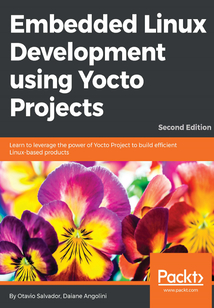首頁 > 工業(yè)技術(shù) >
自動(dòng)化技術(shù)
> Embedded Linux Development using Yocto Projects(Second Edition)最新章節(jié)目錄
舉報(bào) 

會(huì)員
Embedded Linux Development using Yocto Projects(Second Edition)
最新章節(jié):
Summary
IfyouareanembeddedLinuxdeveloperwithabasicknowledgeofYoctoProjectandwanttobroadenyourknowledgewithexamplesofembeddeddevelopment,thenthisbookisforyou.ThisbookisalsoforprofessionalswhowanttofindnewinsightsintoworkingmethodologiesforLinuxdevelopment.
目錄(170章)
倒序
- coverpage
- Title Page
- Embedded Linux Development using Yocto Projects
- Second Edition
- Copyright
- Embedded Linux Development using Yocto Projects
- Second Edition
- Credits
- About the Authors
- About the Reviewer
- www.PacktPub.com
- Why subscribe?
- Customer Feedback
- Preface
- What this book covers
- What you need for this book
- Who this book is for
- Conventions
- Reader feedback
- Customer support
- Downloading the color images of this book
- Errata
- Piracy
- Questions
- Meeting the Yocto Project
- What is the Yocto Project?
- Delineating the Yocto Project
- Understanding Poky
- Using BitBake
- OpenEmbedded-Core
- Metadata
- The alliance of the OpenEmbedded Project and the Yocto Project
- Summary
- Baking Our Poky-Based System
- Configuring a host system
- Installing Poky on Debian
- Installing Poky on Fedora
- Downloading the Poky source code
- Preparing the build environment
- Knowing the local.conf file
- Building a target image
- Running images in QEMU
- Summary
- Using Toaster to Bake an Image
- What is Toaster?
- Installing Toaster
- Starting Toaster
- Building an image to QEMU
- Summary
- Grasping the BitBake Tool
- Understanding the BitBake tool
- Exploring metadata
- Parsing metadata
- Dependencies
- Preferring and providing recipes
- Fetching the source code
- Remote file downloads
- Git repositories
- Optimizing the source code download
- Disabling network access
- Understanding BitBake's tasks
- Extending tasks
- Generating a root filesystem image
- Summary
- Detailing the Temporary Build Directory
- Detailing the build directory
- Constructing the build directory
- Exploring the temporary build directory
- Understanding the work directory
- Understanding the sysroot directories
- Summary
- Assimilating Packaging Support
- Using supported package formats
- List of supported package formats
- Choosing a package format
- Running code during package installation
- Understanding shared state cache
- Explaining package versioning
- Specifying runtime package dependencies
- Package feeds
- Using package feeds
- Summary
- Diving into BitBake Metadata
- Using metadata
- Working with metadata
- The basic variable setting
- Variable expansion
- Setting a default value using ?=
- Setting a default value using ??=
- Immediate variable expansion
- Appending and prepending
- Override syntax operators
- Conditional metadata set
- Conditional appending
- File inclusion
- Python variable expansion
- Defining executable metadata
- Defining Python functions in the global namespace
- The inheritance system
- Summary
- Developing with the Yocto Project
- Deciphering the software development kit
- Working with the Poky SDK
- Using an image-based SDK
- Generic SDK – meta-toolchain
- Using an SDK
- Developing applications on the target
- Integrating with Eclipse
- Summary
- Debugging with the Yocto Project
- Differentiating metadata and application debugging
- Tracking image package and SDK contents
- Debugging packaging
- Logging information during task execution
- Utilizing a development shell
- Using the GNU Project Debugger for debugging
- Summary
- Exploring External Layers
- Powering flexibility with layers
- Detailing the layer's source code
- Adding meta layers
- The Yocto Project layer ecosystem
- Summary
- Creating Custom Layers
- Making a new layer
- Adding metadata to the layer
- Creating an image
- Adding a package recipe
- Automatically creating a base package recipe using recipetool
- Adding support to a new machine definition
- Wrapping an image for your machine
- Using a custom distribution
- MACHINE_FEATURES versus DISTRO_FEATURES
- Understanding the variables scope
- Summary
- Customizing Existing Recipes
- Common use cases
- Adding extra options to recipes based on Autoconf
- Applying a patch
- Adding extra files to the existing packages
- Understanding file searching paths
- Changing recipe feature configuration
- Customizing BusyBox
- Customizing the linux-yocto framework
- Summary
- Achieving GPL Compliance
- Understanding copyleft
- Copyleft compliance versus proprietary code
- Some guidelines for license compliance
- Managing software licensing with Poky
- Commercial licenses
- Using Poky to achieve copyleft compliance
- License auditing
- Providing the source code
- Providing compilation scripts and source code modifications
- Providing license text
- Summary
- Booting Our Custom Embedded Linux
- Exploring the boards
- Discovering the right BSP layer
- Baking for the hardware
- Baking for BeagleBone Black
- Baking for Raspberry Pi 3
- Baking for the Wandboard
- Booting our baked image
- Booting BeagleBone Black from the SD card
- Booting Raspberry Pi 3 from the SD card
- Booting Wandboard from the SD card
- Next steps
- Summary 更新時(shí)間:2021-07-02 15:09:05
推薦閱讀
- Hands-On Deep Learning with Apache Spark
- 大學(xué)計(jì)算機(jī)基礎(chǔ):基礎(chǔ)理論篇
- 21天學(xué)通JavaScript
- 精通MATLAB圖像處理
- Excel 2007函數(shù)與公式自學(xué)寶典
- Mastering VMware vSphere 6.5
- JBoss ESB Beginner’s Guide
- 現(xiàn)代機(jī)械運(yùn)動(dòng)控制技術(shù)
- Photoshop CS3特效處理融會(huì)貫通
- Photoshop CS3圖像處理融會(huì)貫通
- 人工智能趣味入門:光環(huán)板程序設(shè)計(jì)
- 水下無線傳感器網(wǎng)絡(luò)的通信與決策技術(shù)
- SQL Server數(shù)據(jù)庫(kù)應(yīng)用基礎(chǔ)(第2版)
- 基于ARM9的小型機(jī)器人制作
- 重估:人工智能與賦能社會(huì)
- Drupal高手建站技術(shù)手冊(cè)
- 筆記本電腦使用與維護(hù)
- 人工智能:重塑個(gè)人、商業(yè)與社會(huì)
- OSGi原理與最佳實(shí)踐
- Cassandra Design Patterns
- AutoCAD輔助繪圖百練成精
- RPA(流程自動(dòng)化機(jī)器人)入門:手把手教你應(yīng)用UiPath自動(dòng)化工作(全彩)
- AutoCAD 2012中文版完全自學(xué)一本通
- Windows XP操作系統(tǒng)考前12小時(shí)
- 用戶體驗(yàn)樂趣多:寫給開發(fā)者的用戶體驗(yàn)與交互設(shè)計(jì)課
- Python Programming with Raspberry Pi
- Extending SaltStack
- 三維動(dòng)畫綜合實(shí)訓(xùn)
- 工業(yè)機(jī)器人工作站系統(tǒng)集成設(shè)計(jì)
- 看圖學(xué)中文版Windows XP

